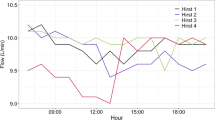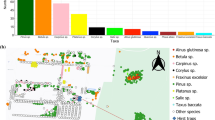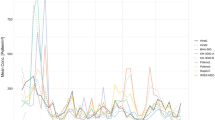Abstract
Standardisation of methods of pollen monitoring networks is vital for data quality. In pollen monitoring networks in Europe, the Hirst-type trap is standard. Hirst traps are calibrated with handheld rotameters. We detected a systematic error in the flow rate calibrated by these standard handheld rotameters. We measured the flow rate of 19 Hirst traps from three commercial brands during calibration but also during monitoring. We used three different rotameters supplied by the manufacturers of the traps, respectively. The actual air flow rate was measured using an electronic heat anemometer with negligible air flow resistance. After calibration to 10 l/min, the rotameter was removed, which led to a significant increase in the flow rate in the range of 10.5–17.2 l/min, a systematic error between 5 and 72%. No significant difference was found between the different commercial trap brands. The analysis revealed that the error depended on the type of the rotameter and the individual trap. The error may be explained by the additional air flow resistance of each rotameter. The total resistance of the system—trap plus rotameter—is higher during calibration when the rotameter is held on the inlet compared to the routine monitoring without the rotameter. Depending on the characteristic curve of the suction pump in the trap (fan), the air flow rate increases to values considerably higher than 10 l/min. Thus, monitoring is done under a higher flow rate than that was calibrated. In order to obtain comparable data within a monitoring network, a solution for correction of this systematic error seems advisable, preferably in cooperation with the manufacturers.





Similar content being viewed by others
Notes
See, for example, http://www.lanzoni.it/vpps-2010.html.
References
Alcázar, P., Galán, C., Cariñanos, P., & Dominguez-Vilches, E. (1999). Effects of sampling height and climatic conditions in aerobiological studies. Journal of Investigational Allergology and Clinical Immunology, 9, 253–261.
Berti, G., Isocrono, D., Ropolo, L., Caranci, N., Cesare, M. R., Fossa, V., et al. (2009). An experience of data quality evaluation in pollen monitoring activities. Journal of Environmental Monitoring, 11, 788–792.
Burge, H. A., Jelks, M. L., & Chapman, J. A. (1986). Quality-control of multisource aeroallergen data. Grana, 25, 247–250.
Buters, J. (2014). Pollen allergens and geographical factors. In: C. Akdis and I. Agache (eds.) Global Atlas of Allergy No. 1. p 36–37. European Academy of Allergy and Clinical Inmunology (EAACI), Zurich.
Buters, J., Prank, M., Sofiev, M., Pusch, G., Albertini, R., Annesi-Maesano, I., et al. (2015). Variation of the group 5 grass pollen allergen content of airborne pollen in relation to geographic location and time in season. Journal of Allergy and Clinical Immunology, 136(1), 87–95.
Buters, J. T., Thibaudon, M., Smith, M., Kennedy, R., Rantio-Lehtimäki, A., Albertini, R., et al. (2012). Release of Bet v 1 from birch pollen from 5 European countries. Results from the HIALINE study. Atmospheric Environment, 55, 496–505.
Cariñanos, P., Emberlin, J., Galán, C., & Dominguez-Vilches, E. (2000). Comparison of two pollen counting methods of slides from a hirst type volumetric trap. Aerobiologia, 16, 339–346.
Carvalho, E., Sindt, C., Verdier, A., Galán, C., O’Donoghue, L., Parks, S., et al. (2008). Performance of the Coriolis air sampler, a high-volume aerosol-collection system for quantification of airborne spores and pollen grains. Aerobiologia, 24, 191–201.
CEN/TS 16868. (2015). Ambient air. Sampling and analysis of airborne pollen grains and fungal spores for allergy networks. Volumetric Hirst method.
Comtois, P., Alcazar, P., & Néron, D. (1999). Pollen counts statistics and its relevance to precision. Aerobiologia, 15, 19–28.
Comtois, P., & Mandrioli, P. (1997). Pollen capture media: A comparative study. Aerobiologia, 13, 149–154.
Cotos-Yáñez, T. R., Rodríguez-Rajo, F. J., Pérez-González, A., Aira, M. J., & Jato, V. (2012). Quality control in aerobiology: Comparison different slide reading methods. Aerobiologia, 29, 1–11.
Cunha, M., Ribeiro, H., & Abreu, I. (2016). Pollen-based predictive modelling of wine production: Application to an arid region. European Journal of Agronomy, 73, 42–54.
de Weger, L. A., Beerthuizen, T., Hiemstra, P. S., & Sont, J. K. (2014). Development and validation of a 5-day-ahead hay fever forecast for patients with grass-pollen-induced allergic rhinitis. International Journal of Biometeorology, 58, 1047–1055.
Galán, C., & Domínguez-Vilches, E. (1997). The capture media in aerobiological sampling. Aerobiologia, 13, 155–160.
Galán, C., Smith, M., Thibaudon, M., Frenguelli, G., Oteros, J., Gehrig, R., et al. (2014). Pollen monitoring: Minimum requirements and reproducibility of analysis. Aerobiologia, 30, 385–395.
Giesecke, T., Fontana, S. L., van der Knaap, W. O., Pardoe, H. S., & Pidek, I. A. (2010). From early pollen trapping experiments to the Pollen Monitoring Programme. Vegetation History and Archaeobotany, 19(4), 247–258.
Gottardini, E., Cristofolini, F., Cristofori, A., Vannini, A., & Ferretti, M. (2009). Sampling bias and sampling errors in pollen counting in aerobiological monitoring in Italy. Journal of Environmental Monitoring, 11, 751–755.
Hirst, J. M. (1952). An automatic volumetric spore trap. Annals of Applied Biology, 39, 257.
Hofmann, F., Kruse-Plass, M., Kuhn, U., Otto, M., Schlechtriemen, U., Schröder, B., et al. (2016). Accumulation and variability of maize pollen deposition on leaves of European Lepidoptera host plants and relation to release rates and deposition determined by standardised technical sampling. Environmental Sciences Europe, 28, 14.
Käpylä, M., & Penttinen, A. (1981). An evaluation of the microscopical counting methods of the tape in Hirst-Burkard pollen and spore trap. Grana, 20, 131–141.
Karrer, G., Skjøth, C. A., Šikoparija, B., Smith, M., Berger, U., & Essl, F. (2015). Ragweed (Ambrosia) pollen source inventory for Austria. The Science of the Total Environment, 523, 120–128.
Levetin, E., Rogers, C. A., & Hall, S. A. (2000). Comparison of pollen sampling with a Burkard Spore Trap and a Tauber Trap in a warm temperate climate. Grana, 39, 294–302.
Mandrioli, P., Comtois, P., Dominguez-Vilches, E., Galán, C., Isard, S., & Syzdek, L. (1998). Sampling: Principles and techniques. In P. Mandrioli, P. Comtois & V. Levizzani (Eds.), Methods in aerobiology (pp. 47–112). Bologna: Pitagora Editrice Bologna.
Orlandi, F., Oteros, J., Aguilera, F., Dhiab, A. B., Msallem, M., & Fornaciari, M. (2014). Design of a downscaling method to estimate continuous data from discrete pollen monitoring in Tunisia. Environmental science: Processes & impacts, 16, 1716–1725.
Oteros, J., Galán, C., Alcázar, P., & Dominguez-Vilches, E. (2013). Quality control in bio-monitoring networks, Spanish Aerobiology Network. The Science of the Total Environment, 443, 559–565.
Oteros, J., Orlandi, F., García-Mozo, H., Aguilera, F., Dhiab, A. B., Bonofiglio, T., et al. (2014). Better prediction of Mediterranean olive production using pollen-based models. Agronomy for Sustainable Development, 34, 685–694.
Pedersen, B. V., & Moseholm, L. (1993). Precision of the daily pollen count. Identifying sources of variation using variance component models. Aerobiologia, 9, 15–26.
R-Team, C. (2013). R: A language and environment for statistical computing. R Foundation for Statistical Computing, Vienna, Austria (http://www.R-project.org).
Šikoparija, B., Galán, C., Smith, M., & EAS QC Working Group. (2016). Pollen-monitoring: between analyst proficiency testing. Aerobiologia. doi:10.1007/s10453-016-9461-3.
Šikoparija, B., Pejak-Šikoparija, T., Radisic, P., Smith, M., & Galán, C. (2011). The effect of changes to the method of estimating the pollen count from aerobiological samples. Journal of Environmental Monitoring, 13, 384–390.
Šikoparija, B., Smith, M., Skjøth, C. A., Radišić, P., Milkovska, S., Šimić, S., et al. (2009). The Pannonian plain as a source of Ambrosia pollen in the Balkans. International Journal of Biometeorology, 53, 263–272.
Sofiev, M., Siljamo, P., Ranta, H., & Rantio-Lehtimaki, A. (2006). Towards numerical forecasting of long-range air transport of birch pollen: Theoretical considerations and a feasibility study. International Journal of Biometeorology, 50, 392–402.
Thibaudon, M., Galán, C., Lanzoni, C., & Monnier, S. (2015). Validation of a new adhesive coating solution: Comparative study of carbon tetrachloride and diethyl ether. Aerobiologia, 31, 57–62.
Tormo-Molina, R., Maya-Manzano, J. M., Fernandez Rodriguez, S., Gonzalo Garijo, Á., & Silva Palacios, I. (2013). Influence of environmental factors on measurements with Hirst spore traps. Grana, 52(1), 59–70.
Tormo-Molina, R., Rodríguez, A. M., & Palacios, I. (1996). Sampling in aerobiology. Differences between traverses along the length of the slide in Hirst sporetraps. Aerobiologia, 12, 161–166.
VDI 4252–4. (2016). Bioaerosole und biologische Agenzien—Ermittlung von Pollen und Sporen in der Außenluft unter Verwendung einer volumetrischen Methode für ein Messnetz zu allergologischen Zwecken. VDI-Richtlinie 4252 Blatt 4, Entwurf. VDI/DIN-Handbuch Reinhaltung der Luft, Band 1a: Beuth, Berlin.
Velasco-Jiménez, M., Alcázar, P., Domínguez-Vilches, E., & Galán, C. (2013). Comparative study of airborne pollen counts located in different areas of the city of Córdoba (south-western Spain). Aerobiologia, 29, 113–120.
Zhang, Y., Bielory, L., Mi, Z., Cai, T., Robock, A., & Georgopoulos, P. (2015). Allergenic pollen season variations in the past two decades under changing climate in the United States. Global Change Biology, 21, 1581–1589.
Ziello, C., Sparks, T. H., Estrella, N., Belmonte, J., Bergmann, K. C., Bucher, E., et al. (2012). Changes to airborne pollen counts across Europe. PLoS ONE, 7, e34076.
Acknowledgements
We thank all organisations, their representatives and members for any support and helpful comments, specially the national and European working groups on standardisation in the VDI/DIN/KRdL 4252 and in CEN WG 39, the participants at the VDI/DIN/KRdL and CEN meetings in Berlin in 2015, Vienna, 2016, and at the ESA meeting in Lyon, 2016, when presenting and discussing the results, the Polleninformation Service of Germany PID, the European Society for Aerobiology and the International Aerobiology Association, namely S. Barral, U. Berger, K.C. Bergmann, M. Bonini, B. Clot, V. Dietze, C. Galan, R. Heesen, U. Kaminsky, M. Kmenta, C. Lhuillery, S. Monnier, S. Nehr, W. Straff, M. Thibaudon, M. Werchan. Further we thank W. Wosniok, Institute for Statistics, University of Bremen, for his assistance in the statistical analysis.
Author information
Authors and Affiliations
Corresponding author
Electronic supplementary material
Below is the link to the electronic supplementary material.
Rights and permissions
About this article
Cite this article
Oteros, J., Buters, J., Laven, G. et al. Errors in determining the flow rate of Hirst-type pollen traps. Aerobiologia 33, 201–210 (2017). https://doi.org/10.1007/s10453-016-9467-x
Received:
Accepted:
Published:
Issue Date:
DOI: https://doi.org/10.1007/s10453-016-9467-x




